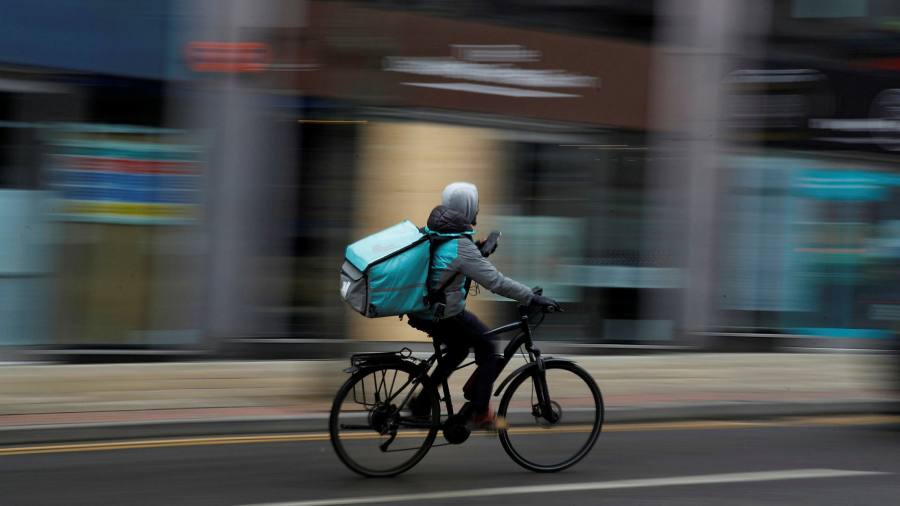[ad_1]
With three meals a day, seven days a week up for grabs, Deliveroo has declared an ambition to cater as many of the 21 “meal occasions†as possible.
In its pitch to investors ahead of its long-anticipated $10bn initial public offering on the London Stock Exchange, the eight-year-old company argues there is still plenty of room to grow in a crowded market.
After ecommerce swallowed everything from books to clothes over the last 20 years, food is one of the largest categories of consumer spending that is least exploited online.
Increasing customers’ order frequency is vital if Deliveroo and other online ordering services such as Just Eat Takeaway, Uber Eats and DoorDash are to deliver sustainable profits. The upfront cost of acquiring a customer, through discounts and freebies, is high so the companies need to maximise their value.
For Deliveroo, it is particularly important for growth. The company derives half its revenues in the highly competitive UK market. Launching in big new markets such as the US, India or even China would be expensive, most likely requiring an alliance with an existing ecommerce player.
That leaves Deliveroo two main paths to expansion: sell existing customers more items or bring more consumers online within its current 12 markets which include the UK, France, Italy, Hong Kong, Singapore and the Middle East.Â
The company argues that its “cohorts†of customers — users acquired in a specific period — typically increase order frequency over time. In its IPO filings, Deliveroo says the average customer of food delivery services makes just one digital order a week in its markets. So there is room for growth here.
Deliveroo also has considerably broadened its offering to consumers since 2013, from its original proposition of restaurants that do not normally serve takeaways, to include fast food, groceries, alcohol and even coffee delivery.
But in each of those add-on categories, fresh competition keeps coming, not least from venture capitalists’ current flavour of the month — rapid convenience-store delivery apps such as Getir, Dija, Weezy and Zapp.
One opportunity for expansion is the suburbs. Deliveroo is an urban creature. City centres have the best restaurants and the population density needed to make the “unit economics†of delivery work for Deliveroo, its couriers and its customers.
Before the pandemic, a good-sized portion of Deliveroo’s orders came from lunching office workers and hungry bankers working late on deals — like co-founder Will Shu himself when he came up with the idea for the app. Now that many of those urban professionals are working from home, perhaps indefinitely, Deliveroo must follow them to the commuter belt.
The model here is US-based DoorDash, the delivery app that is most closely analogous to Deliveroo’s business model. Just as Deliveroo arrived more than a decade after Just Eat, DoorDash launched several years after US food delivery pioneers such as Grubhub and Seamless. It also faced aggressive competition from Uber Eats in downtown areas. So, in the words of one former manager, DoorDash “tactically retreated†to the suburbs.Â
In cities, customers demanded more for less and delivery drivers needed better pay. In the suburbs, it found more families placing larger orders — meaning better margins. Profits soon flowed, allowing DoorDash to return to the city with the stomach to fight Uber and Grubhub.
The British suburbs are more densely populated than in the US, which plays to Deliveroo’s strengths. But they are less of a greenfield opportunity. Just Eat already covers most of the country and Uber is already available to 75 per cent of the UK population. Deliveroo has said it will take until the end of this year to cover two-thirds of the UK.Â
Deliveroo’s challenge is that the profits from its urban markets, which it needs to fuel its suburban expansion, are under threat from a resurgent Just Eat. As it builds up its fleet of couriers to offer a Deliveroo-style service around the world, Just Eat spent €712m on delivery costs last year but charged consumers just €231m in delivery fees.
Deliveroo may be hoping that DoorDash’s successful IPO — its shares popped 86 per cent on its first day of trading last December — will whet investor appetites. It will need a hefty serving of capital from its IPO if it is to take a bigger slice of the growing food-industry pie.
tim.bradshaw@ft.com
[ad_2]
Source link





